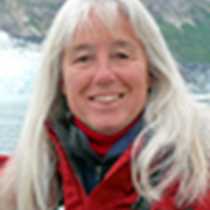Ideal Cove/Petersburg
This morning the National Geographic Sea Lion cruised in smooth waters and under bright blue skies to an anchorage at Ideal Cove, located on the southeast side of Mitkof Island. Our Zodiacs threaded through crab trap buoys and brought us to our landing for hikes in the forest.
Although it was a dry, sunny day, it was still evident that this is a rain forest, lush and moist, with many shades of green. Nurse logs, full of nutrients and moisture, support miniature forests. Temperate rainforests have more biomass than tropical rainforests. Every square inch is covered with living matter and the trees get quite tall. Many of us were pleased to find twinflowers in bloom, bright yellow scrambled egg slime mold, and a banana slug.
Those who chose to explore by Zodiac reported seeing many bald eagles and everyone enjoyed the exceptional weather.
Captain Dion deftly maneuvered the National Geographic Sea Lion into a tight spot alongside the dock at Petersburg, a friendly fishing town with Norwegian heritage. Many options were available for people this afternoon. It was certainly a spectacular day for flightseeing, and those who chose that activity were treated to a great perspective of the Le Conte Glacier and its environs.
Some people took the chance to visit an interesting muskeg environment, accessed through the forest on Kupreanof Island via a boardwalk. This type of wetland is characterized by an open habitat with shore pine, sphagnum moss, plants of the heath family, standing pools of water, and poor drainage. High acidity inhibits bacterial action and creates a harsh environment for growth as well as decay. Carnivorous plants found here have evolved to absorb additional nutrients from insects.
Bicycles were available for touring through town and along the shoreline. Some people preferred to walk and visit the shops.
We were back on board for the cocktail hour, appetizers, recap and our Dungeness crab feast. After dinner Dr. Andy Szabo gave a presentation on humpback whales and the research done through the Alaska Whale Foundation. Protection of these endangered animals has allowed them to slowly recover. Lindblad Expeditions/National Geographic helps support this and other conservation programs in Southeast Alaska.
The National Geographic Sea Lion cruised northward through Frederick Sound and Stephens Passage toward another day’s adventure.




